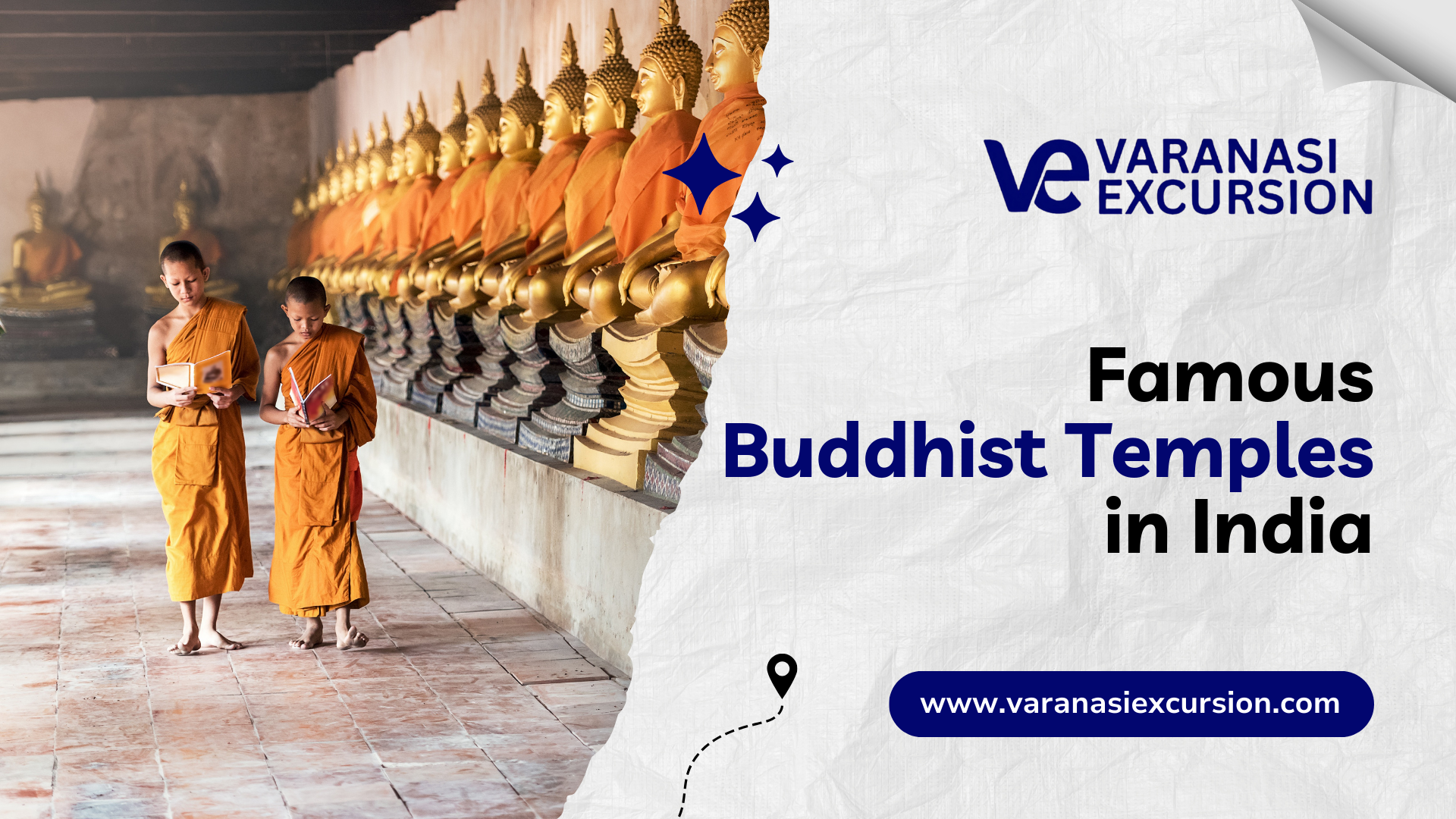“I don’t even know why I wanted to check out all these temples,” I told my friend on our trip.
He just laughed and said, “Bro, you’ve barely seen the spiritual side of India. Have you even been to a real Buddhist temple?”
Truth? I hadn’t.
I knew about Bodh Gaya and a few famous spots, but actual quiet, centuries-old monasteries hidden in different corners of India? That was all new to me.
A bit about me, I love traveling, but I usually just hit the obvious touristy stuff everyone talks about. This time, I wanted something different. You know, places with history, peace, and a spiritual vibe.
So yeah, I went on a hunt for Buddhist temples across India. From the famous ones that pull crowds from everywhere to tiny hidden gems most people never see. And honestly, it opened my eyes.
In this guide, I’ll walk you through the popular temples, a few secret spots for explorers, and some practical tips to plan your visit in 2025. By the end, you’ll have a good idea of how to dive into India’s Buddhist heritage yourself.
Brief overview of Buddhism in India

Before we dive into the temples, a quick background on Buddhism in India, don’t worry, I’ll keep it short.
Buddhism actually started right here in India, over 2,500 years ago, with Siddhartha Gautama, yep, the Buddha. The story goes he was a prince who ditched a life of luxury to figure out the truth about suffering and happiness. After years of meditation, he got enlightened under a Bodhi tree in Bodh Gaya, Bihar.
From there, Buddhism spread all over India and even further including places like Sri Lanka, China, Cambodia, and Southeast Asia.
Back home, it gave us some amazing architecture: stupas, monasteries, and temples that still stand today, showing how devoted generations of people were.
The thing is, even though Buddhism started here, it kind of faded in some parts of India over the centuries. But the temples and monuments remain, and they still pull in pilgrims, history buffs, and curious travelers. Visiting them isn’t just sightseeing, it’s like stepping into a 2,500-year-old story.
Buddhist temples across India: State by state guide
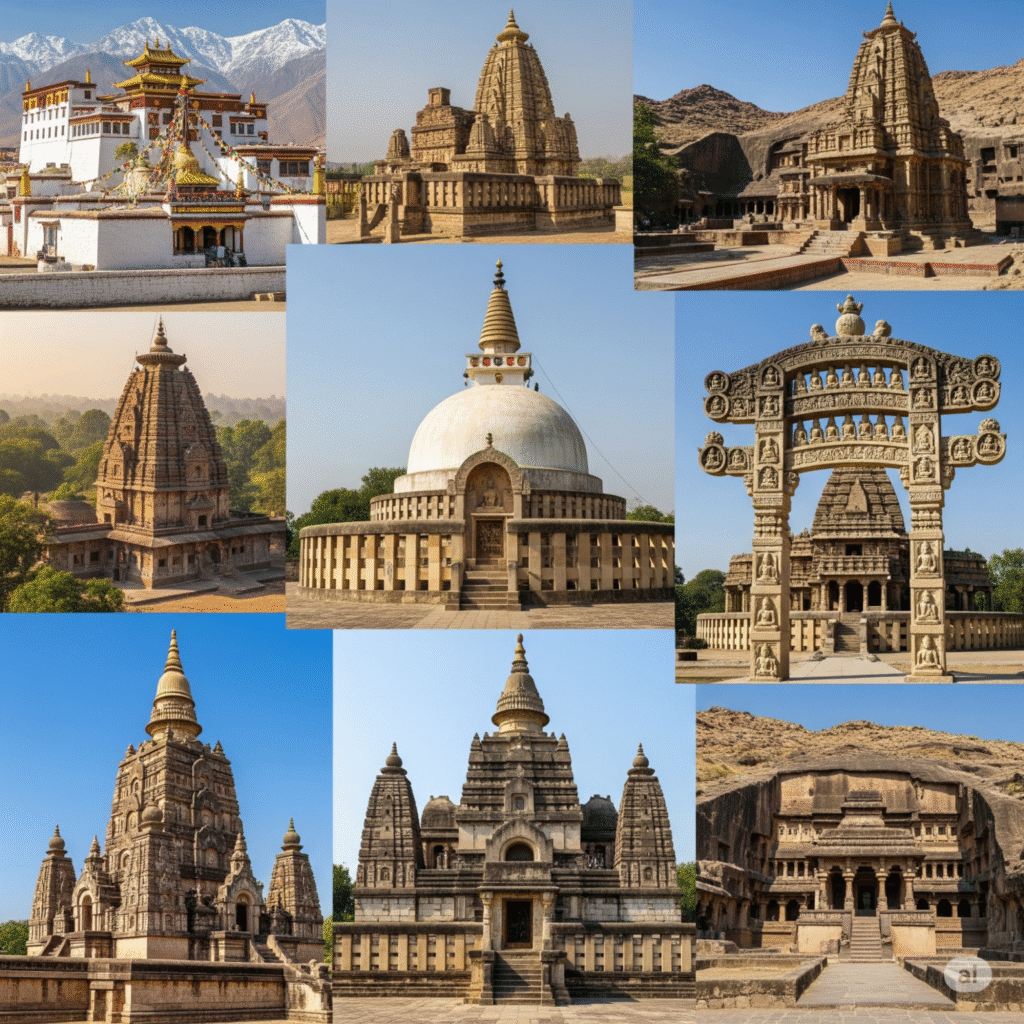
India’s Buddhist heritage is spread all over, from the snowy monasteries in Ladakh to the old rock-cut caves in Maharashtra. If you’re planning a spiritual trip or just love history and old buildings, here’s a state-wise list of some of the most important Buddhist temples and monasteries you can check out.
| State / Region | Key Buddhist Sites | Highlights / Why It Matters |
| Andhra Pradesh | Amaravati, Bavikonda, Bojjannakonda, Thotlakonda, Phanigiri | Hilltop stupas and old monastery ruins that show how Buddhism spread in the early days. |
| Arunachal Pradesh | Tawang Monastery, Golden Pagoda (Namsai), Tawang Taktshang, Urgelling Monastery, Rigyalling | Himalayan monasteries where you can see Tibetan Buddhist traditions in action. |
| Bihar | Mahabodhi Temple, Nalanda, Rajgir, Vaishali | The place where Buddha got enlightenment, plus an ancient university and other key history spots. |
| Chhattisgarh | Sirpur Group of Monuments (Buddhist vihara), Pragyagiri Monastery, Bhongapal, Mainpat Tibetan Monastery | Archaeological remains, a monastery on a hill, and even a small Tibetan-style settlement. |
| Delhi (NCT) | Buddha Jayanti Park Vihara, Sri Lanka Maha Bodhi Temple (in adjoining region) | A quiet vihara in the city where you can just sit and think in peace. |
| Goa | Lamgao Buddhist Caves, Arambol Harahara, Margao, Rivona sites, Karma Kagyu Buddhist Center, multiple Viharas in villages | Ancient Buddhist caves along with some newer meditation centres. |
| Gujarat | Devni Mori Stupa (Sabarkantha) | A rare early stupa design you don’t see in most places. |
| Haryana | Kushan-era stupas near Yamunanagar (Chaneti) | Some very old but lesser-known Buddhist structures. |
| Himachal Pradesh | Tabo, Key, Dhankar, Gandhola, Tangyud, Tayul Monasteries | Ancient Buddhist sites in Spiti Valley. |
| Jammu & Kashmir / Ladakh | Alchi, Hemis, Thiksey, Diskit, Lamayuru, Phugtal, Mulbekh, Spituk, and more | Rich Ladakhi monastery culture with old rituals still alive. |
| Karnataka | Namdroling Monastery (Golden Temple, Bylakuppe) | A huge Tibetan-style monastery in the south of India. |
| Kerala | Karumadikkuttan statue in Ambalapuzha | A rare Buddhist relic in a place that’s mostly Hindu. |
| Madhya Pradesh | Sanchi, Deur Kothar, Bharhut Stupa | Iconic stupas and rock carvings from early Buddhist art. |
| Maharashtra | Ajanta, Ellora, Bhaja, Karla, Kanheri, Deekshabhoomi, Global Vipassana Pagoda, Chaitya Bhoomi | From ancient caves to modern pilgrimage spots with big crowds. |
| Manipur | Buddhist temple in Moreh | Places that matter for cultural ties with other countries. |
| Meghalaya | Buddhist monastery near Shillong or Ghoom-like site in the hills | A living Buddhist community in the northeast. |
| Mizoram | Buddha temple in Aizawl | A Buddhist presence in a state that’s mostly Christian. |
| Nagaland | Dimapur Buddha Vihar | A temple that’s a symbol of different religions living in harmony. |
| Odisha | Dhauli Shanti Stupa, Ratnagiri, Lalitgiri, Udayagiri | Ashokan edicts and remains of big monastery complexes. |
| Punjab | Small monasteries near Dharamshala or meditation centers | Places becoming popular for Buddhist retreats. |
| Rajasthan | Vipassana centers (e.g., Thali near Jaipur) | Spots that focus more on meditation than temples. |
| Sikkim | Rumtek, Pemayangtse, Dubdi, Enchey, Ralang, Tashiding, Phodang | Major Tibetan Buddhist learning centres. |
| Tamil Nadu | Chudamani Vihara, Sri Lanka Maha Bodhi Centre (Chennai), Perunjeri Buddha Temple | Old Buddhist heritage right inside a big city in the south. |
| Tripura | Buddha Mandir (Agartala) | A local pilgrimage spot known to nearby villages. |
| Uttar Pradesh | Sarnath, Kushinagar, Shravasti, Mathura area sites | Important Buddhist sites close to Varanasi. |
| Uttarakhand | Mindrolling Monastery (Dehradun) | A big Nyingma Buddhist centre in the Himalayan foothills. |
| West Bengal | Ghoom (Darjeeling), Tibetan monasteries on hills, several small vihara | Buddhist culture in the eastern Himalayas. |
Famous Buddhist temples in India that you must know
India has some of the most beautiful and historically cool Buddhist temples in the world.
From quiet monasteries hidden in the mountains to big temples full of centuries of devotion, each place has its own story.
Here’s a list of the famous Buddhist temples in India you should definitely check out if you’re planning a trip in 2025.
Mahabodhi Temple, Bodh Gaya (Bihar)
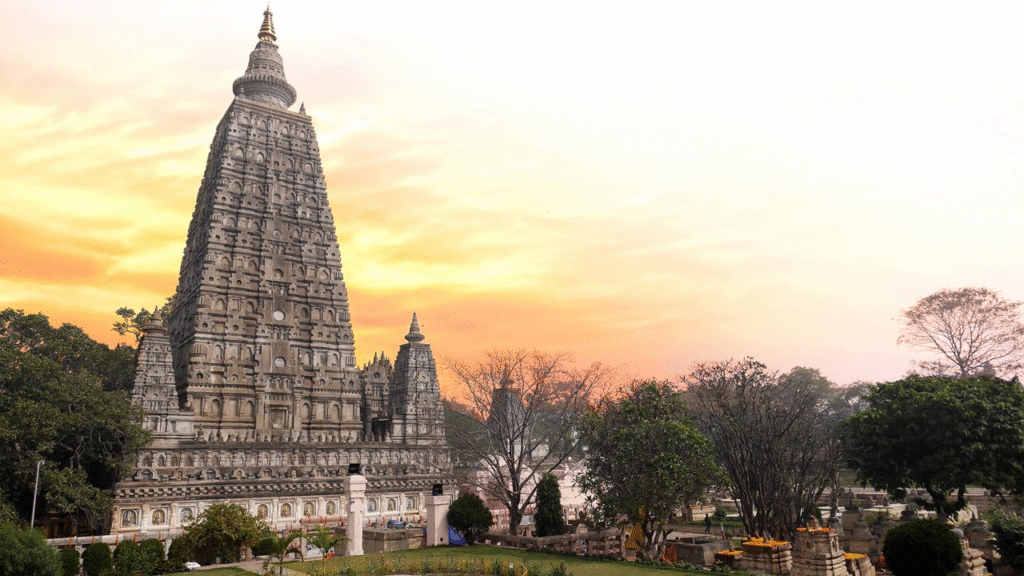
The Mahabodhi Temple in Bodh Gaya is probably the most important Buddhist site in the world. This is where Prince Siddhartha became Buddha under the Bodhi tree around 531 BCE. The temple you see today mostly comes from the 5th-6th century CE, but the first one was built by Emperor Ashoka way back in the 3rd century BCE.
Over time, it got damaged, neglected, and restored, but now it stands tall at 55 meters with its pyramidal shikhara and amazing carvings. Inside, there’s a golden Buddha statue in the earth-touching pose, said to be over 1,700 years old, and right next to it is the Bodhi tree, a descendant of the original.
The whole temple complex is huge, almost 5 hectares and has several other sacred spots tied to Buddha’s enlightenment.
Some fun bits: the Vajrasana or Diamond Throne marks the exact spot Buddha meditated, Ashoka’s pillar with inscriptions is at one corner, and monks from all over the world visit here. Even the Dalai Lama comes sometimes, especially between October and March when the weather is just perfect.
📌 Related: Buddhist Pilgrimage Sites in India: A Complete Guide to Sacred Destinations
Sarnath (Uttar Pradesh)

Sarnath is one of those spots that just hits you with history. It’s where Buddha gave his first sermon after getting enlightened and started the first Buddhist monastic community. It’s only a short drive from Varanasi. The big Dhamek Stupa is impossible to miss and is around 128 feet tall and is covered in delicate carvings.
There’s also the Chaukhandi Stupa, Dharmarajika Stupa, and a small Archaeological Museum with the Ashoka Lion Capital, the same lion that’s India’s national emblem. Buddha spent 24 rainy seasons teaching here. The place was forgotten for centuries and then rediscovered in 1798.
If you go between October and March, the weather’s nice for quiet walks through Deer Park. Walking there, it’s easy to imagine monks from hundreds of years ago moving along the same paths.
Kushinagar (Uttar Pradesh)
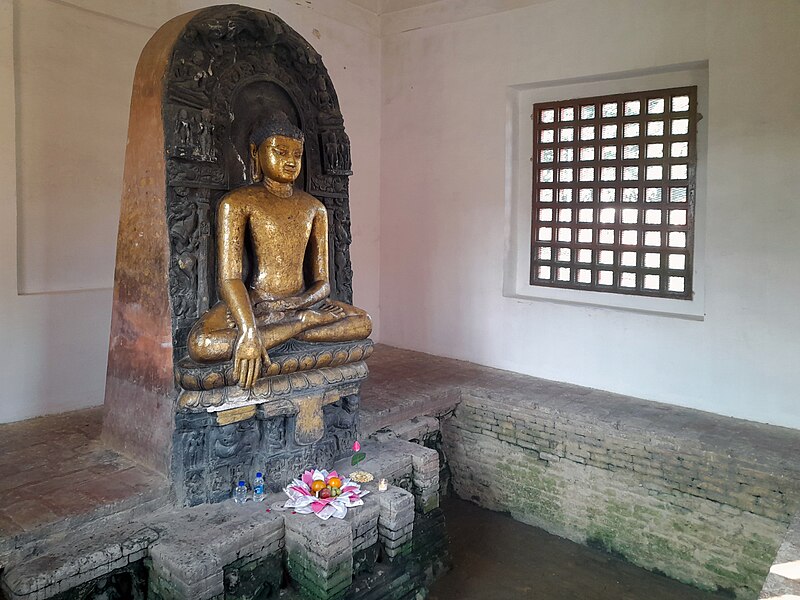
Kushinagar hits you differently because it’s where Buddha passed away at 80 and reached Parinirvana (final liberation). His final journey ended here among the sal trees, and the Mahaparinirvana Temple has this massive 6-meter-long reclining statue of him carved from red sandstone.
Nearby, the Ramabhar Stupa marks where he was cremated and is 49 feet tall. The history here is wild, after Buddha died, his ashes were split among eight clans, which led to ten major stupas being built across India. The site stayed important until the 12th century, and archaeologists say this is really the spot where he died.
The best time to visit is October to March when the weather’s nice, and it just feels right for reflecting and soaking in the place like a proper pilgrimage.
Ajanta Caves (Maharashtra)

The Ajanta Caves feel like stepping into another world. Carved into rock between the 2nd century BCE and 6th century CE, they show how Buddhism evolved from Hinayana to Mahayana through some of the most stunning murals and sculptures you’ll ever see.
They were hidden for centuries and only rediscovered in 1819 by a British officer named John Smith. Inside, you’ll find chaityas (prayer halls) and viharas (monasteries) covered in frescoes of Jataka tales, Buddha’s life, and Bodhisattvas. Cave 1 has the famous Padmapani and Vajrapani murals, and Cave 26 has a reclining Buddha that’s just breathtaking.
What blows your mind is that some of these paintings have kept their colors for almost 1,500 years! The best time to go is October to March when the weather’s perfect for wandering and really taking it all in.
📌 Related: 13 Top Buddhist Monasteries in India for Travelers in 2025
Ellora Caves (Maharashtra)

Ellora is another jaw-dropping place, and it really shows religious harmony. There are 34 caves in total: Buddhist, Hindu, and Jain, all carved right next to each other. The Buddhist ones, caves 1 to 12, are especially cool if you want to see later Mahayana and Vajrayana influences.
Cave 10, called Vishvakarma Cave, is the only Buddhist chaitya here and has amazing carvings plus a stupa. Caves 11 and 12 are three-storied monasteries with intricate mandalas and Vajrayana symbols. These caves were carved from the top down and pretty impressive engineering for ancient times!
Like Ajanta, the best time to go to Ellora is from October to March. So you can explore comfortably without sweating through everything.
Nalanda Ruins (Bihar)

Nalanda isn’t just a temple or monastery. It’s something where the world’s first international university stood, from around the 3rd century BCE to the 13th century CE. Walking through the ruins, you can almost feel the energy of thousands of students and teachers who lived and studied here.
The site was originally linked to Buddha’s disciple Sariputra and later expanded by dynasties like the Guptas and Palas. At its peak, there were over 10,000 students and 2,000 teachers. The library, called Dharmaganja, supposedly held millions of manuscripts, and when it got burned during Bakhtiyar Khalji’s invasion, it reportedly smoldered for three months.
The ruins spread across 12 hectares and include 11 monasteries, 6 brick temples, and even some sophisticated ancient drainage systems.
The best time to visit is October to March when the weather’s just right for exploring and imagining what life must have been like at this ancient center of learning.
Other Buddhist temples that you might be interested in
Besides the famous spots, India has a bunch of hidden Buddhist temples most travelers haven’t heard of.
These little gems are perfect if you want some peace or a more real, off-the-beaten-path experience. Visiting them feels like stepping into another world, where history, spirituality, and quiet vibes all mix together.
If you’re into discovering places that aren’t packed with tourists, these temples are totally worth checking out.
Kesariya Stupa (Bihar)

Kesariya Stupa is seriously impressive, it’s actually considered the tallest Buddhist stupa in the world at 104 feet. Built during the Mauryan period, some say Emperor Ashoka might have commissioned it, and it’s believed to be the spot where Buddha gave his final sermon.
The stupa got even bigger during the Gupta period with added terraced levels, and British archaeologists started digging it up in the early 19th century, showing just how massive it really was. Today, you can see six terraced levels with detailed sculptures of Jataka tales and scenes from Buddha’s life, though it’s thought it used to be even taller.
The best time to visit is October to March when the weather’s perfect for exploring.
Fun fact: This stupa influenced Buddhist architecture across Southeast Asia and even has relics believed to be linked to Buddha’s last teachings.
Bharhut Stupa (Madhya Pradesh)

Bharhut Stupa is one of those places that really throws you back in time. It dates to the 2nd century BCE, during the Sunga period, and is famous for some of the earliest and finest Buddhist sculptures in India.
A lot of it has been dismantled over time, but the railings and gateways that remain are covered in panels showing Buddha’s life and Jataka tales, basically stories teaching morals. It was built before famous sites like Sanchi and Amaravati and even influenced their designs later on.
Fun fact: Alexander Cunningham documented it in the 19th century, and many of its artifacts are now in the Indian Museum in Kolkata. Visiting Bharhut gives you a real sense of how Buddhist art and storytelling started shaping culture centuries ago.
Piprahwa Stupa (Uttar Pradesh)

Piprahwa Stupa is really cool because it might actually have some of Buddha’s original relics. It’s in Siddharthnagar, close to Kapilavastu, where Buddha was born.
A British archaeologist, William Claxton Peppe, found it in 1898. He discovered a soapstone box with inscriptions saying how Buddha’s relics were shared among different clans. The stupa itself was built around the 3rd century BCE and has the classic round dome with little chambers for relics.
Being here feels like stepping right into history. And knowing it’s connected to Buddha’s own family, the Shakya clan, makes it even more amazing.
Dungeshwari Cave Temples (Bihar)
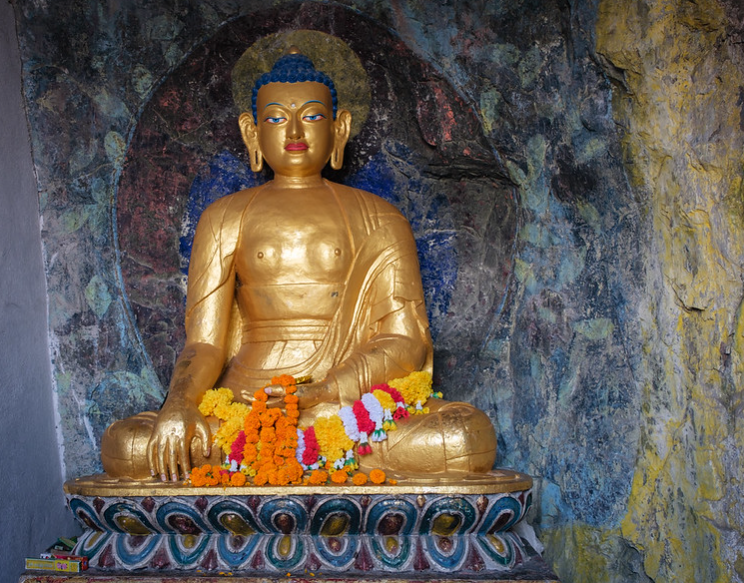
Also called the Mahakala Caves, this is where Buddha spent six years meditating before he reached enlightenment. They’re tucked away in a quiet forest near Bodh Gaya and feel really peaceful, like no one has messed with them.
The rocks have carved meditation chambers, and there are stone sculptures and inscriptions from different times. Going here between October and March is best, and if you pay attention, you can almost feel the spiritual energy that locals say is still around from Buddha’s time.
Bhaja Caves (Maharashtra)

The Bhaja Caves near Lonavala go back to the 2nd century BCE and are some of the earliest rock-cut Buddhist sites in India. There are 22 caves, and they were basically monsoon retreats for traveling monks.
The main chaitya hall has stone carvings that look like wooden beams with a cool little detail. The viharas are simple but practical, with carvings showing Buddhist stories and a bit of ancient Indian life. The best time to visit is October to March, though the monsoon makes the nearby waterfall really beautiful.
Karla Caves (Maharashtra)

The Karla Caves have the biggest and best-preserved ancient chaitya hall in India. Carved between the 2nd century BCE and 5th century CE near Lonavala, they really show how skilled the old builders were.
The Grand Chaitya, Cave 8, has a 45-foot high vaulted ceiling and amazing sculptures, with wooden details carved in stone. The caves also have a small Hindu temple, which shows how different faiths coexisted back then.
Kanheri Caves (Mumbai)

The Kanheri Caves are spread across Mumbai’s Sanjay Gandhi National Park and have 109 caves showing over a thousand years of Buddhist history. They started as simple meditation retreats and later became a sort of university that drew scholars from all over Asia.
Cave 3, the main chaitya hall, has 34 pillars and impressive Buddha statues. There are also clever ancient water systems. The best time to visit is October to March. So you can wander around and imagine the monks and students who lived and studied here.
Amaravati Stupa (Andhra Pradesh)

Amaravati Stupa in Guntur district was once called the “greatest monument in Buddhist Asia,” and it’s easy to see why. Built between the 3rd century BCE and 250 CE under the Satavahana dynasty, it got support from local merchants and craftsmen, not just kings.
The stupa originally stood 95 feet tall and was decorated with marble panels showing Buddha’s life, Jataka tales, and delicate floral designs. It influenced Buddhist art across Southeast Asia, and even the Dalai Lama held ceremonies here in 2006.
Vikramashila Ruins (Bihar)
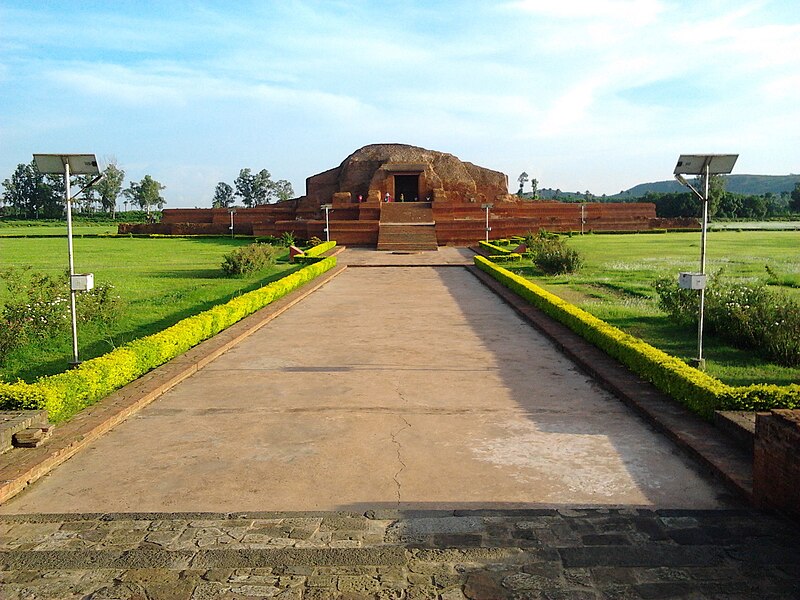
Vikramashila was one of India’s top Buddhist universities, started in the 8th-9th century CE when Nalanda was declining. It focused on Vajrayana (Tantric) Buddhism and had over 100 teachers and 1,000 students.
The main cruciform stupa sits on a 300-foot platform, surrounded by a monastery with 208 cells. The best time to visit is October to March. Even now, you can see the clever planning and drainage systems, and it’s easy to imagine the busy scholarly life that once happened here.
Tawang Monastery (Arunachal Pradesh)

Tawang Monastery is India’s largest and the world’s second-largest, sitting over 10,000 feet up in the Himalayas. Founded in 1681, it’s a major Gelugpa (Yellow Hat) Buddhist center and is home to around 450 monks.
The three-story complex has bright murals, ancient thangkas, and a library full of rare texts like the Kangyur and Tengyur collections. The best time to visit is April to October for mountain views, though March is great if you want to see snow-covered peaks.
Fun fact: the 6th Dalai Lama was born nearby, which makes it even more special.
Sanchi Stupa (Madhya Pradesh)
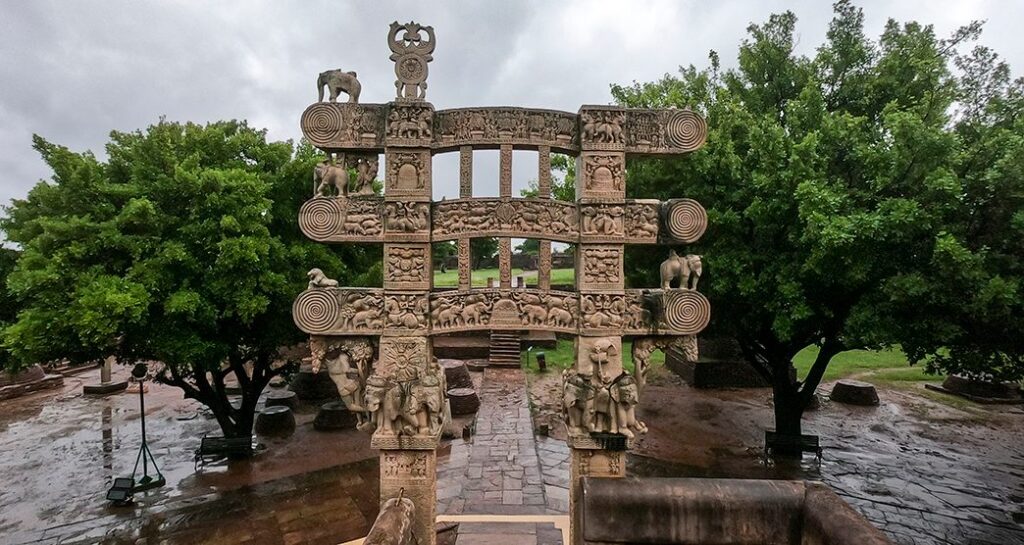
Sanchi Stupa is probably the most famous Buddhist monument in India. It was built by Emperor Ashoka way back in the 3rd century BCE. It started as a simple brick-and-mud dome over Buddha’s relics but was later enlarged in sandstone during the Sunga period, giving us the beautiful stupa we see today.
The dome is 17 meters high and 37 meters wide, with a circular terrace for walking around and a triple umbrella on top for Buddha, Dharma, and Sangha. The four toranas at the main directions are full of carvings showing Jataka tales and old inscriptions, really cool to see up close.
The best time to visit is October to March, with clear skies and comfortable weather.
Fun facts: The toranas are considered a high point of Indian stone sculpture, Sanchi’s Ashokan pillar inspired India’s national emblem, and it even appears on the ₹200 note!
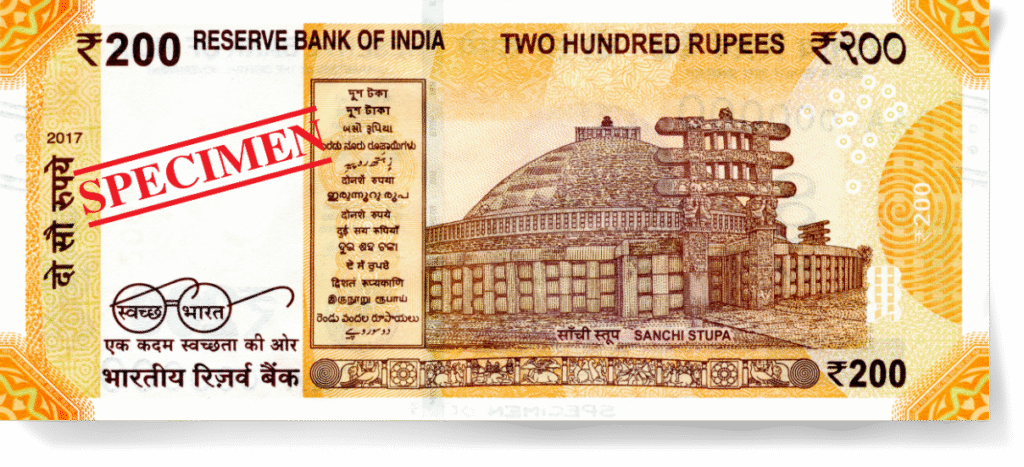
Rajgir / Gridhakuta Hill (Bihar)
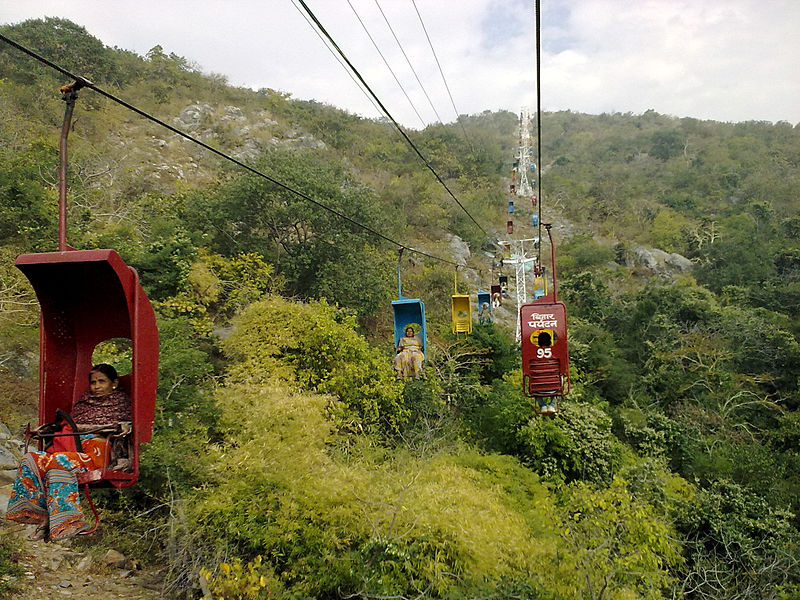
Also called Vulture’s Peak, this 400-meter hill near Rajgir was one of Buddha’s favorite spots. He spent several rainy-season retreats here and taught important Mahayana sutras like the Heart Sutra and Lotus Sutra.
The hill actually looks like a vulture, and the quiet rocks make it perfect for meditation. A short 30-minute hike from Rajgir town takes you to caves, meditation platforms, and a small shrine marking where he gave sermons.
The best time to go is October to March when the trails are dry and the weather’s nice.
Fun bits: the Heart Sutra and Diamond Sutra were first preached here, there’s a Japanese Peace Pagoda built in 1969, and you can see ruins of monasteries used by Sariputta and Moggallana.
Lumbini (Nepal)

Even though it’s in Nepal, Lumbini is a must-visit if you’re doing the Bodh Gaya–Lumbini route. This is where Siddhartha Gautama was born around 624 BCE. The main spot has the Maya Devi Temple, built by Ashoka in 249 BCE. You’ll see the marker stone, a nativity sculpture, and the holy pond where Queen Maya bathed before giving birth.
The area spreads over 60 km² and has international monasteries, stupas, and the Lumbini International Research Institute. The best time to visit is October to March, though it gets really crowded during Buddha Purnima.
Fun bits: the Ashoka pillar confirms it as Buddha’s birthplace, excavations show viharas and stupas from the 3rd century BCE, and the monasteries reflect architecture from all over Asia showing how connected Buddhist countries are.
If you’re a foreigner planning to visit, you’ll need a Nepal visa. Most travelers get a double-entry tourist visa on arrival, which is valid for 15, 30, or 90 days.
It’s simple: you pay a fee at the airport or border, show your passport with at least six months’ validity, and you’re good to go. This is handy if you want to combine a trip to Bodh Gaya in India with Lumbini in Nepal.
Travel guide and practical information

Planning a trip to India’s famous Buddhist temples might feel a bit overwhelming at first, but it’s actually easier than you think if you break it down. Most key sites are spread across Bihar, Uttar Pradesh, Maharashtra, Madhya Pradesh, Andhra Pradesh, and Arunachal Pradesh, so it helps to plan your route region by region.
Getting there:
- By air: Major cities like Bodh Gaya, Varanasi, Lucknow, Patna, Mumbai, Bhopal, and Guwahati have airports. From there, you can take cabs or local buses to reach temples and caves.
- By train: India’s railways connect almost all the main sites. Bodh Gaya, Sarnath, Kushinagar, Nalanda, and Rajgir are well-connected, making travel pretty easy.
- By road: Renting a car or taking buses works well for nearby sites like Ajanta-Ellora, Bhaja-Karla, or Kanheri. Driving also gives you freedom to stop at smaller, lesser-known spots along the way.
Best time to visit:
Most Indian sites: October to March because at this time the weather is cool, dry, and comfortable for sightseeing and hiking.
Tawang Monastery: April to October for clear mountain views. March can be magical too if you want snow-capped peaks.
Accommodation:
You’ll find everything from budget guesthouses to mid-range hotels and luxury stays. Bodh Gaya, Sarnath, and Tawang are particularly tourist-friendly. For a more immersive experience, try staying at monasteries or dharmashalas in Bodh Gaya, Rajgir, or even Lumbini.
Local tips:
- Dress modestly at temples and monasteries.
- Shoes are usually removed before entering prayer halls.
- Carry water, snacks, and a hat or sunscreen for day trips.
- Many sites require walking or light hiking, so wear comfortable shoes.
- Respect local customs and keep noise low in sacred areas.
Food and drinks:
Most tourist spots have small cafes or local eateries. Bodh Gaya, Rajgir, and Nalanda have plenty of vegetarian-friendly options, while Lonavala and Mumbai caves have more mainstream choices. Trying local food wherever you go is part of the experience!
Connectivity:
Most major sites have decent mobile coverage, but some remote caves and Tawang might have patchy signals. Download offline maps if you rely on GPS.
Travel made easy:
If you’re thinking, “This sounds amazing, but planning it all sounds stressful,” you’re not alone. Varanasi Excursion offers curated Buddhist tours across India, covering key pilgrimage spots like Bodh Gaya, Sarnath, Kushinagar, Nalanda, Rajgir, and more.
Whether you want a 7-day private Buddhist tour or a 10-day complete Buddhist circuit, from Buddha’s birth to parinirvana, we handle itinerary, transport, guides, and accommodation. You just relax and enjoy the temples, caves, and spiritual vibes.
Trust me, a knowledgeable local guide makes a huge difference. Because you’ll hear stories, history, and hidden gems you’d probably miss on your own.
Tours we offer at Varanasi Excursion
👉 7 Days Private Buddhist Tour
👉 10 Days Buddhist Circuit with Birth to Death Place of Buddha
👉 For customized Buddhist tour you can visit Varanasi Excursion or call us at +91 9005104999.
Ready to explore India’s Buddhist side for yourself?
When I started this trip, I thought I was just ticking “Buddhist temples” off a travel list. But somewhere between the busy courtyards of Bodh Gaya and the quiet halls of hidden monasteries, I got it that this isn’t just about places. It’s about feeling how old this land is, hearing the echoes of history, and slowing down enough to notice it.

If you want to see India’s Buddhist side for real, Varanasi Excursion can take you there. We know the famous spots you’ve seen online, but also the small, peaceful ones where monks still chant in the morning and nobody’s waving a selfie stick in your face.
And if you’re coming from outside India, here’s one thing to know, many Buddhist trails cross into Nepal (like Lumbini, Buddha’s birthplace). For that, you’ll need a double-entry Indian visa. It’s just like a normal visa, but it lets you leave India, visit Nepal, and come back without trouble. Sort it before you fly, and you’ll save yourself a big headache later.
Your 2025 trip doesn’t have to be just another holiday. It can be a journey you’ll carry with you for life.
Namo Buddhaya 🙏

